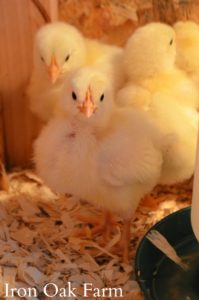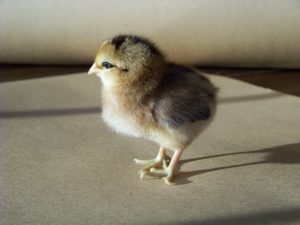 By Jennifer Sartell
By Jennifer Sartell
Usually, around this time of year, I start getting e-mails and Facebook messages from people about roosters. The reason for this is that around this time of year, spring cockerels start crowing, which is the last confirmation that your supposed pullet chick, is, in fact, a boy.
Lots of people start contacting me asking if I’m looking for a rooster, or if I know of anyone who is. Unfortunately, the answer is usually no. It’s sad really, roosters are beautiful creatures and I’d love to keep them all! But they’re troublesome in the farm/backyard setting. Too many roosters will often fight with each other and beat up your hens. They also stand as another mouth to feed without much contribution to the income of the farm. They’re obviously needed for breeding, but one rooster will serve up to 12 hens. And then there’s the crowing noise and the neighborhood associations and ordinances banning roosters.
Because of this, it can be really difficult to re-home a rooster to someone who isn’t going to butcher it at some point. I understand the mentality that chickens can be pets and I respect that. This is why if we do take in roosters, I’m always upfront that at some point he may be processed if we get too many.
Over the years, I’ve gotten pretty good at being able to sex chicks. It’s a hard thing to try and teach someone because male and female chicks look almost identical. Sexing is different with each breed and I feel like it has a lot to do with experience and years of watching chicks move around in the brooder. Rooster chicks just act differently. But hopefully, I can shed some light on the subject, and you too will be able to sex your own chicks and be sure of what you’re bringing home.
First, let’s get some terminology straight.
Pullets
When you visit a feed store, you will often see a bin labeled “pullets”. Pullets are young, female chickens who haven’t reached sexual maturity. When you pick chicks from a pullet bin, the sexing isn’t 100% accurate. It’s said that the chicks should be 97% female, but I think that number is too high; with experience I think it’s more like 85% and the rest are males. So when you select pullets, you have a 3-15% chance of getting a rooster among the bunch.
Straight Run
A straight run is a batch of chicks that are not sexed, so you have a 50/50 percent chance of getting male or female.
So if you only want females, start out selecting from the pullet bins.
I like breeding my own chicks at our farm, so often I am looking for the rooster in the bin.
 My guesses worked really well this year and of the chicks I pulled from the pullet bin at our local feed store, I managed to get a Leghorn rooster and two Easter Egger Roosters, which I was really excited about. I will be able to breed these guys next spring!
My guesses worked really well this year and of the chicks I pulled from the pullet bin at our local feed store, I managed to get a Leghorn rooster and two Easter Egger Roosters, which I was really excited about. I will be able to breed these guys next spring!
Here’s a few tips that work for me:
Behavior
Cockerel chicks often have different body language than pullets. They will walk more upright, they may stand to the side and observe other chicks eating and drinking in a confident sort of way and they are often bossier.
Legs and Feet
Cockerels will have thicker legs, their toes will also be thicker and longer. They may also have more upright thigh and shank (straighter legs).
Size
Cockerels are often bigger and fluffier, especially the feathers on top of their head.
Wings
In some breeds, if the primary wing feathers are even in length, it’s a cockerel. If they’re uneven it’s a hen.
Chest

Cockerel Chick
Cockerels stand with their chests upright and then there is a slight hollowness to their under abdomen. Pullets will be more rounded and set lower, more parallel to the ground. Their bodies are also more football shaped.
Comb
The comb on a cockerel is usually wider and stands taller than a pullet.
Wait to Buy
If you can, wait a little while to buy your chicks. The older a chick is, the easier it is to sex. Don’t wait too long so that the store sells out before you get any, but even a few days can give you a better clue as to what sex the chick is. All of the above signs will become more and more apparent as the chick ages.
Sexing Easter Eggers

Female Easter Egger
This trick has worked for me for years. Easter Egger roosters are the light grayish-white ones. They’re usually really fluffy too. I’ve never been wrong in this observation. While this post might have been more helpful written in the spring, I used this method to sex out our spring chicks in hope of getting a rooster and as the chick aged, I started second-guessing myself because the cockerel seemed small. But nope! The chick in question is a rooster after all.

This is the rooster the above chick became.
Sexlink
If you really want to make sure you know what chicks you are getting, buy a breed that is color-coded. Sexlinks are a variety of crossbred chickens where the males are a certain color and the females will be different. This makes the sexing process very easy.













9 Comments
I meant to say I bought 9 chicks. Speaking text doesn’t always work for me lol.
How about 9 chicks from the 4-H club a few weeks ago. They are around 4 weeks old. I think that most are Easter Eggers and I am trying to start sexing them. Is there a place I can send a few pictures?
I meant to say I bought 9 chicks. Speaking text doesn’t always work for me lol.
In regard to chicks, I’ve found that the more sharply defined spots or stripes that are on their down, the more likely they are female. Barred rock chicks all have a white spot on their head. The clearer or more defined the spot is, they are more likely to be female. A lot of EE chicks have stripes. Again, if the stripes are sharply defined, especially the one running behind the eye, I find that they will be female. And yes, if they are from the same hatch, the taller more straight up standing ones are more likely to be roos. Only 8 years having chickens, but this advise has proven pretty accurate for me.
Great article, very informative. Thank you!
The hatcheries that I have gotten chickens from have been 100% correct with the sexing of the birds. It amazes me! Like anything else, the more you do it the better you become at it. I would love to be able to sex chickens when they are hatched!
Look on YouTube for videos of how to vent sex chicks. There are also methods to to wing sex them on there, too.
Thanks for all your tips.
In the Easter Egger photos, I notice the one you point out as a cockerel is the one looking straight at the camera. I found this to be true with my EE cockerel (I originally thought was female based on wing feather sexing…I know, it doesn’t work for all breeds. I’m a total newbie to hatching and sexing and was looking for ANY sign I could find! ) He also was the lighter colored one, though he was more cream to butter colored primarily. I was certain his sister was the opposite and for all of the opposite reasons! She was dark brown and wing feathers were opposite of what I expected. None of her pics are facing the camera but to this day he is not afraid of “eye contact” with the camera or “in person”….and at 3 1/2 months old now, both of their coloring is wildly different from when they hatched!
I concur your account with the EE chicks, it matches my own experience thus far, however limited it may be. I will be looking for all of these signs going forward!
Thanks for sharing your experience!